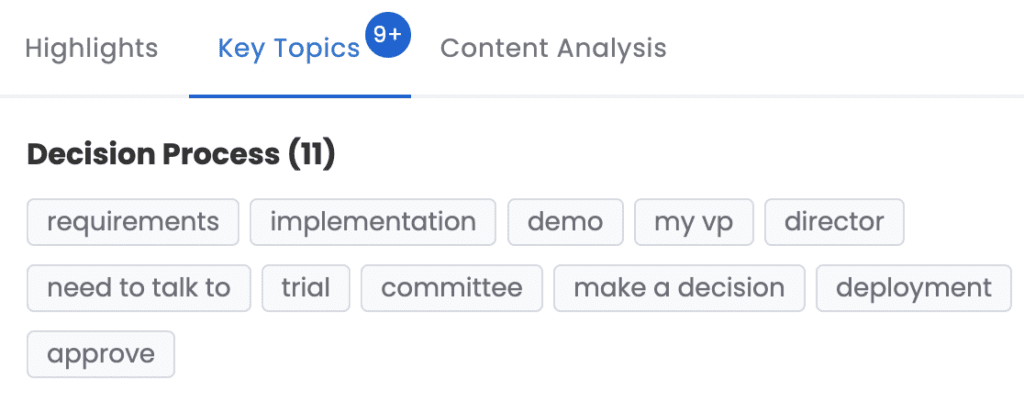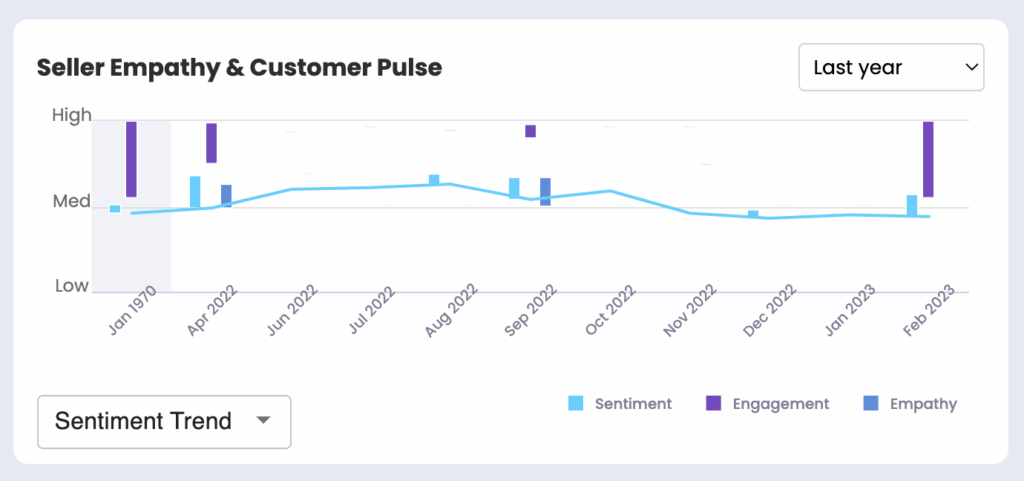You’re all in on conversation intelligence. You’ve talked to your fellow sales leaders. You know the main benefits of recording, transcribing, and analyzing sales calls. And now, you’re ready to evaluate solutions to find the one that’s right for you.
But woah, there are a lot of players in the revenue intelligence space. You could go with a category leader (that’s a safe bet, right?). Or you could learn about the capabilities of different solutions to pinpoint a tool that’s right for you. (You might find that a niche solution or rising star is a better fit.)
Here’s what we’ll cover in this article:
Begin your evaluation by eliminating obvious poor fits
How does conversation intelligence work?
What makes a good conversation intelligence solution?
At which stage should you consider a conversation intelligence solution?
- Factors to consider when choosing a conversation intelligence solution
Begin your evaluation by eliminating obvious poor fits
Sometimes the easiest way to buy technology is through the process of elimination. There are always a few options you can eliminate off the bat.
The truth is, most conversation intelligence platforms offer similar capabilities and features. They:
- Automatically record voice conversations.
- Transcribe sales conversations and prospect calls.
- Pinpoint keywords and topics.
- Score sales rep performance.
- Score sales team performance.
- Score deal health.
Some tools lumped into the “conversion intelligence solutions” category offer basic enterprise call recording and speech-to-text transcription but no true call intelligence. Call transcription is table stakes. You, my friend, are looking for the whole enchilada.
Identify these obvious poor fits first, and scratch them off your list. Now you’re ready to move into the next evaluation phase: evaluating lots of good options.
To help you narrow your list further, we’ve compiled 11 key attributes of a good conversation intelligence software below. You’re welcome.

But first, a quick refresher on how conversation intelligence works. This overview will give you a good understanding of standard capabilities and features to look for.
How does conversation intelligence work?
Most conversation intelligence solutions work similarly. Here’s a high-level overview:
They record and transcribe conversations.
Transcription means sales reps can focus on selling and not note-taking.
Most tools also jot down action items, so post-call follow-up is a breeze.
They use natural language processing and machine learning algorithms to detect keywords, or phrases said during a conversation.
For example, an important keyword for most companies is “price.” So the tool listens for that word and flags it as a key moment.
They categorize keywords and phrases into topics.
Say one topic is “pricing.” Then, within that topic, you’ll have keywords like “price,” “cost,” and “budget.” This makes it easy to find topically-relevant soundbites—even if the buyer doesn’t use the broad, topical keyword.
Check out this screenshot from Q for Sales by Uniphore. It shows 11 keywords that relate to the topic “decision process”:
They highlight key moments.
Did your decision maker say, “I need to talk to my Chief Technology Officer about implementation”? If so, they used two keywords related to the decision process. These keywords are meaningful, so the tool will flag it as a key moment.
They analyze the sentiment of each conversation.
High-quality conversation intelligence solutions don’t just flag key moments and leave you to figure out what those moments mean. Instead, they flag key moments and tell you what that moment means. Additionally, they help you understand buyer sentiment over time.
They score sales reps’ performance.
Conversation intelligence solutions exist to help reps close more deals. Increasing your close rate involves improving your selling skills. Rep scoring functionality helps reps build self-awareness (“Wow, I didn’t realize I talked so fast”). It also highlights improvement areas managers can target for post-call sales coaching.
Most tools score reps on talk ratio and talk speed. Q also scores reps on empathy, politeness, and hesitation. As you can see, Q for Sales scores reps across five areas:
If you see that all of your top-performing reps have a talk ratio of 50%, you can coach the rest of your reps to follow suit.
OK, now you’re clear on standard functionality. If a conversation intelligence solution can’t do all the above, you don’t want it. (Your shortlist is shaping up nicely!)
What makes a good conversation intelligence solution?
Now it’s time to get into the fun stuff: 11 key attributes to look for when evaluating conversation intelligence solutions.
Easy to use
Alex Newmann, CEO of Newmann Consulting Group, says the first thing he looks for when helping clients evaluate conversation intelligence solutions is “simplicity and ease of use.”
You’re probably thinking, well, duh. But it needs to be said: if a tool isn’t easy to use, reps won’t use it. So when you’re demoing solutions, look at the UX. Is it intuitive?
Integrates with existing systems
If you’re an enterprise organization, you know that no new tool will ever be truly “easy to set up.” But things at least go smoother when the conversation intelligence tool integrates with your other systems (call recording software, CRM, outbound engagement tool, etc.).
Aligns with your sales methodology
Let’s say your org uses MEDDPICC. Look for a conversation intelligence solution that can pull in relevant topics from your CRM. For example, “decision process” or “economic buyer.” Otherwise, we predict a lot of manual uploading in your future.

Analyzes non-verbal communication
Most conversation intelligence tools use AI to analyze verbal cues (what was said). But as every salesperson who’s ever thought a call went well only to be ghosted knows: buyers don’t always tell you what they’re thinking and feeling. After all, while B2B buyers are logical, they’re also human. Humans are complex.
A robust conversation intelligence tool solves this problem by analyzing verbal and non-verbal cues.
Remember our example where the buyer said, “I need to talk to my Chief Technology Officer about implementation”? If your conversation intelligence solution only analyzes verbal cues, you only get a partial picture. The tool might flag this sentence as a key moment that influences buyer sentiment—but what was the buyer actually feeling when they said this?
When you layer on non-verbal cues like tone of voice, pupil dilation, and facial expressions, you get a richer understanding of what the buyer was thinking and how they were feeling when they said something.

Emotional Insights
Sentiment is the positive or negative emotion a buyer displays, while engagement is the level of compromise and attention a buyer displays.
Together, we refer to sentiment and engagement as emotional insights. Emotional insights are extremely important. As research shows, engaged buyers buy and disengaged buyers don’t. Likewise, buyers who show positive sentiment buy while buyers who show negative sentiment don’t. When sellers can track buyer engagement and sentiment, they can better control deal outcomes.
Like we said above, many tools offer sentiment analysis. But not every tool provides buyer sentiment analysis and buyer engagement analysis using computer vision. Not every tool opens your eyes to seller actions that influence buyer engagement and sentiment.
When you have a conversation intelligence tool that utilizes computer vision to see beyond verbal cues, you can:
• Get a clearer view of buyer and seller emotions
• Build seller EQ (emotional intelligence).
• Have better buyer interactions.
• Get a better sense of which deals are expected to close, which are at-risk but able to be saved, and which are dead in the water.
Accurate insights
Another capability that tops Alex’s list is accurate transcription. Accurate transcription is important because it enables accurate insights. If your transcription is inaccurate, AI could miss critical keywords and fail to surface key moments.
You also need a tool that understands context for accurate keyword interpretation. Let’s say a buyer uses a keyword that indicates buying intent, but says it in a sarcastic tone of voice. You want a tool that analyzes both the words said AND the person’s tone, so your sellers can better understand buyer emotions.
One Deloitte study found that biometrics (the study of people’s physical and behavioral traits) provided detailed insights no other form of feedback could capture. Body signals reveal how buyers truly feel. But it’s not like we can place our buyers in a scientific lab and force them to wear electrodes on their scalps and faces to measure emotional signals like attention, arousal, and valence.
The next best way to get inside our buyers’ heads is to use a conversation intelligence tool hat analyzes verbal and non-verbal cues over video calls.
Semantic Search
As we mentioned at the top of the article, conversation intelligence tools use natural language processing and machine learning algorithms to detect keywords or phrases said. But not every tool recognizes semantic—or related—keywords.
For example, say your system looks for the keyword “price.” A tool that lacks semantic search capabilities might ignore related words like “amount” or “fee.” Of course, you could manually add every possible variation, but you have better things to do.
Scalability
One recent survey found that scalability is the No. 1 valued platform capability among C-suite leaders. Whatever solution you choose should easily accommodate the addition of new learners and workflows. And it should be powerful enough to analyze large amounts of data—even if conversations become more complex over time.
If you’re an enterprise org, scalability is a must. But, not all conversation intelligence solutions meet the needs of enterprise buyers.
Real-time Insights
Of course, you want to analyze your calls after you hang up. But you also need a tool that provides real-time insights so you can self-correct in the moment.
For example, say your decision maker’s engagement rate is declining mid-call. But you miss the cues because you’re screen sharing and speaking into the green light.
The best conversation intelligence tool alerts you on a real-time app when someone’s engagement is dropping or they seem confused.
Data security and privacy
If you’re like most GTM leaders, the idea of conversation intelligence solutions creeped you out a bit at first. That’s normal. Privacy is a concern.
A good conversation intelligence solution should be able to provide accurate insights into prospect and customer conversations while ensuring everyone’s personal information is protected.
But let’s take privacy a step further. Some vendors say “your privacy is our top concern.”

Then they turn around and share user data as part of their marketing efforts. For example, “Companies that use our tool to do x, experience y and z.”
Do you really want smaller competitors to benefit from your decades of experience and hard work?
Cost-effectiveness
You’ve heard the adage: There’s good, there’s fast, there’s cheap. Pick two.
And while we wouldn’t recommend buying the cheapest conversation intelligence solution, we do recommend finding a conversation intelligence tool you can try for free before making a long-term commitment.
Right now, you can try Q for Sales for free for six months!
At what stage should you consider a conversation intelligence solution?
Short answer: When you have sales leaders interested in using the tool for coaching reps.
Alex says, “It is rare to see a company with a mature enough sales team that will analyze and self-coach themselves using the tool. It doesn’t matter if you are a startup or a public company.”
Side note
While this article is focused on sales teams, conversation intelligence powers the entire business. It’s often used by customer service teams, marketing teams, customer success teams, and even product teams!
Factors to consider when choosing a conversation intelligence solution
As you can see, when selecting a conversation intelligence solution, there are many factors to consider.
Does it integrate with our current systems? Does it save us time? Does it recognize semantic keywords? Does it look beyond verbal cues to give us a read on what buyers and customers are thinking but not saying?
Does it help our sales team improve their soft skills and emotional intelligence?
Adopting a new solution is a big decision, and you want to weigh all your options. If you need more help, here are the 7 best conversation intelligence tools for 2023.
)





